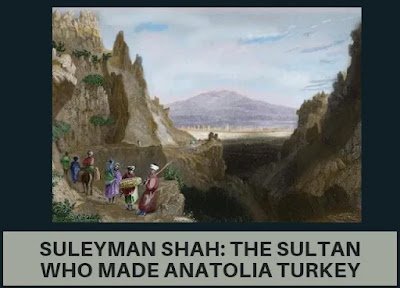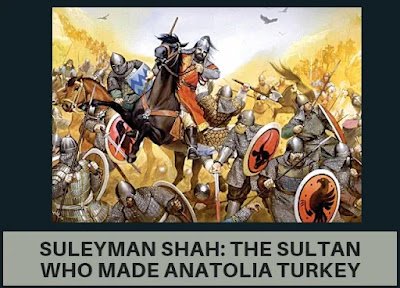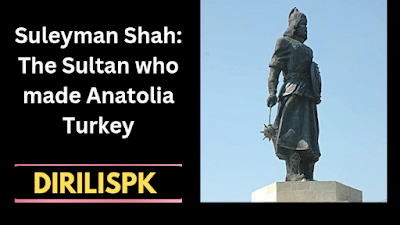Upon the death of Alp Arslan in 1072, Süleymanşah and his brothers found an opportunity and were released and sought asylum in Anatolia. The days when Süleymanşah, who captured and dominated many castles here, would make Anatolia a Turkish homeland, were very close.
Anatolian Conqueror Kutalmışoğlu Süleymanşah (d. 1086) The Seljuk ruler who founded the Turkish Seljuk State after the Battle of Manzikert… He had to fight against Byzantium on the one hand, and Armenians on the other, the Great Seljuk State and the Syrian Seljuks; because the eyes of the rulers and amirs were on these precious lands, where they had stepped down. The war tactics and administrative strategies of this sultan, who fit glorious conquests in his short life, say a lot to us Anatolian residents of a century later.
The Sultan who made Anatolia Turkey: Suleyman Shah
Süleymanşah is the grandson of Arslan Yabgu, the eldest son of Selçuk Bey, the ancestor of the Seljuks. His father, Melik Kutalmış, fought and lost Alp Arslan in the struggle for the sultanate after Tuğrul Bey’s death. It is known that Kutalmış died in this war and Alp Arslan captured his sons named Mansur, Alp İlik, Devlet and Süleymanşah.
Although Alp Arslan first thought of eliminating these children, it was decided to keep them under surveillance after the warning of the Vizier Nizamülmülk, “I am afraid that your killing will cause your state to collapse and bring bad luck to you”.
Upon the death of Alp Arslan in 1072, Süleymanşah and his brothers found an opportunity and were released and sought asylum in Anatolia. Süleymanşah first marched on Antakya with the Khorasan Turkmens who joined him, but he could not conquer it. Then he came to Konya and took this city from Martavkusta and Gavele (Gevele) Castle from Romanus Makri.
The commander, who captured and dominated many castles in Anatolia, whose names we do not know, succeeded in getting as far as Iznik by gaining superiority over the governors. He took advantage of the throne struggles in Byzantium and tried to hold on in the Marmara Region. He would soon find himself in a game of thrones.
Nikephoros Botaneiates, who declared himself the Byzantine Emperor on 7 January 1078, asked Süleymanşah for help. Because he needed a support force against Nikephoros Bryennios, who claimed to be an empire. After defeating his enemy with the troops sent by Süleymanşah, he entered Istanbul on March 24 and became the emperor.

While Byzantium was agitated with internal turmoil, Süleymanşah’s conquest of Iznik (1078) was not difficult. Thus, the first Muslim-Turkish state in Anatolia, whose capital was Iznik, was established. Of course, Melikşah, the Great Seljuk Sultan, who followed a centralist policy, would need to intervene in these developments in Anatolia.
He sent an army under the command of Emir Porsuk on Iznik, the capital of Süleymanşah. This army, which besieged Iznik, had to return without achieving any results other than killing Süleymanşah’s elder brother Mansur.
In Byzantium, Nikephoros Botaneiates had become emperor with the support of Süleymanşah, but Nikephoros Melissenos, who was married to the sister of Alexios Komnenos, would not be late to raise the flag of rebellion against Botaneiates by gathering many Turkish warrior forces and Turkish chiefs around him. Thus, the Seljuks of Turkey found themselves once again in the middle of the Byzantine throne struggles. Nikephoros Melissenos set out for Istanbul from the island of Kos (Kos) where he lived. He was hailed as the emperor in the Anatolian cities he visited, even though he was wearing purple imperial clothes.
Of course, there would be a reward for the military support provided to him. He left all the cities of Western Anatolia, Phrygia and Galatia (the cities and castles on Denizli and Ankara sides) to the Turks. An important Byzantine source unequivocally records that the Turks captured the city of Cyzicus (Belkıs) near Erdek at this time.
Melissenos came to Iznik again with the support of Süleymanşah. As soon as Botaneiates learned of the situation, he immediately sent an army under the command of Eunuch John to Nicaea and besieged the city. However, in a short time, the Seljuks shouted and attacked the eunuch Ioannes’s troops with arrows they fired from all directions. The Byzantine troops, who had suffered heavy casualties, had no choice but to flee. Meanwhile, Alexios Komnenos and his elder brother Isaakios Komnenos had also revolted in the western part of the empire, and were advancing towards Istanbul with the soldiers they had gathered and some Turkish troops. When Melissenos came to Üsküdar, the Komnenos brothers were pressing Istanbul. Thereupon, Melissenos offered the Komnenos to divide the empire among them. One of the brothers Alexios and Isaac would also become the emperor of the lands to the west. However, after delaying his brother-in-law for a while, Alexios answered in the negative. After obtaining the empire, he would give Melissenos the administration of the city of Thessaloniki with the rank of kaiser.
Turkish influx to Anatolia begins
With this new situation in Byzantium, as a result of Süleymanşah’s establishment of the Turkish Seljuk State and his successful conquests, in 1080, crowded Turkish masses began to flow from Azerbaijan to Anatolia like a flood. Thus, the Turkish population in these lands increased rapidly.
Due to the unrest caused by the endless political and economic depressions in Byzantium, local peoples such as Armenians, Assyrians and Georgians soon adopted the rule of Süleymanşah. The peasant class, who worked in the service of large landowners and was treated as captives, gained their freedom under the mîri land regime under the Seljuk rule and became landowner.
Meanwhile, Süleymanşah, who was not in any treaty or alliance with the new emperor, captured the Anatolian lands up to the Bosphorus in a short time with the Seljuk forces accompanying him. Now the border between Byzantium and Seljuk Turks was the Bosphorus waters. If the Seljuks made some effort, they could supply ships and cross to the European side, and even take Istanbul.
As it is understood from the records kept by Anna Komnenos, the daughter of Emperor Alexios, Süleymanşah had already started to collect taxes from the ships passing through the Bosphorus, with the outposts and customs offices he established on the Harem-Saacak-Üsküdar coast, on the opposite shore of Istanbul.
Although Emperor Alexios tried to drive the Turks away from the Bosphorus with several night raids, he was unsuccessful. At this time, the Normans and Byzantium were in trouble with the invasion of the Balkans. Since the Balkan front became urgent for the emperor, he had no choice but to agree with Süleymanşah.
According to the Treaty of Drakon Water made in June 1081, the Seljuks would withdraw their borders with Byzantium as far as the creek called Drakon. (Drakon, according to some historians and geographers, the place where Dragos Hill in Maltepe is located today, and according to others it is Kırkgeçit Creek within the borders of Kocaeli.) This treaty was the recognition of Byzantium’s Turkish Seljuk State and the reign of Süleymanşah at its head, and It is important in terms of determining the border of the two states in 1081.
According to the treaty, Süleymanşah received a large amount of money from the Emperor, and both sides promised military aid to each other. As a matter of fact, the Seljuk Emir (Kamyres), sent by Süleymanşah at the head of a military force of 7 thousand people, would play an important role in the struggle of Alexios against the famous leader of the Normans, Bohemund.
By the beginning of the 11th century, Byzantium occupied Eastern Anatolia and removed the small Armenian kingdoms here and settled them in Sivas and Kayseri; Seljuk raids and conquests also caused the Armenian people to move a little further west. In other words, Armenians concentrated in regions and cities such as the banks of the Euphrates, Taurus Mountains, Cilicia, Malatya, Maraş and Urfa. However, the Armenians would not be comfortable in these new residence areas. Byzantium’s forcing the Armenians to migrate, and more importantly, their pressure and torture to join the Orthodox sect made the Armenians hostile to the Greeks.
The Armenians, who did not interfere with the defense of Anatolia, saw the Turks as saviors from time to time and continued their national and religious hatred against Byzantium. In the Battle of Manzikert, they did not fight against the Seljuks and left the battlefield and left the Byzantine army and emperor to their fate. The Armenians, who took advantage of the collapse of Byzantium and the success of the Turks against Byzantium, established principalities in the Euphrates region, thus cutting off the connections of the Turkish Seljuks with the Turkish-Islamic countries in the east and south.

New destination: Cilicia
Armenian Governor Philaretos, who was assigned to defend the Malatya-Antakya line against the Turks, betrayed Romanos Diogenes by not making a serious fight in the Battle of Manzikert, and after the war he did not recognize the empire of Mikhail Dukas and began to act independently.
Philaretos, who also benefited from the activities of the Turks in Anatolia during the reign of Michael, which was in great confusion, captured the most important cities of the Cilicia region, Tarsus, Mamistra and Anazarba (Anazarva), and one of his commanders captured Urfa (Edessa/Ruha) in 1077. He took it from the Byzantines.
In 1078, the people of Antakya, hoping to protect themselves against the Turks, invited him here and came under his rule. In this way, the sovereignty area of Philaretos included a very wide area from the Taurus to Urfa.
Philaretos, while showing his allegiance to Alexios when he became the head of Byzantium, while acting cautiously, he tries to rule the Muslims by paying tribute to the Muslim ruler of Aleppo, Şerefü’d-devle Muslim. He was trying to establish good relations with
When the dates showed the year 1082, Süleymanşah went on an expedition to Cilicia this time. First, he conquered the historical city of Tarsus in the Çukurova region. The fact that he sent an envoy to the Shiite ruler of Tripoli, Kadi Ibn Ammar, and demanded a judge and an orator for the newly conquered city, shows that he recognized the Shiite Fatimids instead of the Abbasids due to the family and political rivalry between him and the Great Seljuks.
In 1083, he conquered Adana, Misis (Mamistra, Masisa), Anazarba (Dilekkaya) and other cities and towns in Cilicia, which belonged to the Armenians in the same region, and returned to Iznik.
When Philaretos fell out with his son Barsam (Barsama), whom he left as a commander in Urfa the following year, he had him arrested and imprisoned in Antakya Castle. But Barsam, who was released from prison by forming an alliance against his father with Ismail, the Muslim figure of Antakya Castle, while his father was in Urfa, talked to Süleymanşah in İznik and informed him that he wanted to hand Antakya over to him.
While Süleymanşah left Ebu’l-Kasım, one of his most valuable commanders, as his deputy in Iznik, he sent different governors to the regions of Anatolia that were subject to the Seljuks. Meanwhile, one of his commanders, Karategin Bey, who is buried in Çankırı today, was also conquering the cities of Çankırı, Kastamonu and Sinop.

Extra History Of Suleyman Shah:
While Süleymanşah was advancing towards Antakya, Emir of Danishmend Gümüştekin Ahmed Gazi was pressing Malatya in the hands of Armenian Gabriel, while Emir Buldacı, one of the Turkish commanders, was conquering Elbistan and its surroundings. It seems that this work was done in coordination by the Turkish commanders and lords. Because the aforementioned region was located within the dominion area of Philaretos and it seems that the military power in his hands was aimed to be disintegrated.
In order to prevent his movement from being heard, Süleymanşah traveled at night and hid in the valleys during the day. He had the horses of his men reversed so that it would not be known that he was marching on Antakya, thus avoiding the surveillance and control of the spies in the vicinity.
According to the anonymous Seljukname, he had passed his soldier through the Euphrates without a ship. (According to the famous Byzantine historian Anna Komnene, he reached Antakya after 12 nights of walking. Aksarayî, the author of one of the most important sources of Seljuk history, says that he reached Antakya after a 5-day walk.)
Seljuk forces, who secretly entered the city with the help of the Muslim Shah Ismail on 12 December 1084, dominated Antakya without encountering any major obstacles. However, some of Philaretos’ men and their forces took shelter in the inner castle and resisted Süleymanşah’s troops. Therefore, the citadel surrendered on January 12, 1085, after a month’s siege.
Since Süleymanşah captured the city by agreement, he treated the people well, freeing the captives and forbade his soldiers from entering the houses and marrying the daughters of the people of Antakya.
He converted the Great Mar Cassianus Church into a mosque as a symbol of the conquest and an indication of its becoming an Islamic city; The first Friday prayer was held on 17 December 1084.
It would not go without saying that the Armenians and Assyrians, who were fed up with the persecution of Byzantium and the Armenian ruler Philaretos, were very happy with this conquest. So much so that, with the permission of Süleymanşah, they had the churches of Virgin Mary and Aziz Cercis built. Süleymanşah preferred to leave the commander who delivered the inner castle with Shahne Ismail. He reported the conquest of the city with the conquerors he sent to the neighboring rulers and lords and to Melikşah.
Süleymanşah, who had conquered the city with a cavalry force of 300, reinforced his military force with other troops he called from the center and conquered Ayntâb, Harim, Dülük, Tellbâşir, Ra’ban, İskenderun and Süveydiye (Samandağı).
As for Philaretos, Would you believe if we said that he accepted Islam by appearing before Melikşah? Thus, he came to Maraş, which was given to him by the Sultan, and continued his life here, and died in the same place before 1090.
Emir of Aleppo Şerefüddevle Müslim b. The Quraysh were receiving a tax of 30 thousand gold from Philaretos, the former ruler of Antioch. His intention was to receive the same tax from the new ruler. He sent a message to Süleymanşah and asked him to send this jizye (tax).
It was against Islamic law to demand jizya from a Muslim city and its Muslim ruler. Naturally, Süleymanşah rejected this offer and war became inevitable.
Big competitor :
Süleymanşah and Muslim b. The Quraysh met on 20 June 1085 (24 Safar 478) in the Kurzahil region between Aleppo and Antakya. Along with Şerefüddevle was Çubuk Bey, who had established a principality near Harput (Elazığ). In fact, he captured the city of Harput during the disintegration of the state founded by Philaretos, and later increased his power by taking the Tunceli region under his dominance.
During the Kurzahil War, Şerefüddevle Müslim was defeated and killed along with his 400 leading men, when he and many Turkmen under his command went to the side of Süleymanşah. After the victory, Süleymanşah marched to Aleppo and besieged it.
Meanwhile, Şerefüddevle’s body was buried in front of the Aleppo gate.
It was inevitable for Süleymanşah to face the Great Seljuks as a result of fighting and killing the Emir of Aleppo, Şerefüddevle, who was subject to Sultan Melikşah, and then besieging Aleppo.
Emir Şerif Abu Ali Hasan, the deputy left by Şerefüddevle in Aleppo, defended the city against Süleymanşah, on the one hand, and on the other hand, wrote a letter to both Melikşah and Syrian Seljuk Meliki Tutuş to either come personally to take over the city or to save it. He asked them to send a strong army.
Meanwhile, Süleymanşah besieged the city and captured the Seyzer, Kefertab, Ma’arratü’n-nu’man and Kınnesrin castles around Aleppo.
Tutuş also wanted to take Aleppo. For this reason, he took action with Artuk Bey, the famous commander of the Seljuks, and set out for Aleppo.

Final Words:
Finally, Melik Tutuş and Süleymanşah went to war on 4 June 1086 (18 Safer 479) in Aynü Seylem, three miles from Aleppo. Çubuk Bey, who was on the side of Süleymanşah at first, changed sides again when the war started.
After a tough struggle, this time Süleymanşah was defeated.
His vizier Hasan b. A significant part of his soldiers, including Tahir, was taken prisoner. His sons Kılıç Arslan and Kulan Arslan were taken to Isfahan by Melikşah and kept under surveillance.
Matheos from Urfa says that Süleymanşah was killed by the soldiers of Tutuş during the war. There is also a record that he committed suicide because he did not want to fall into the hands of Tutuş.
It is rumored that Melik Tutuş, while walking around the battlefield with his men after the victory, showed a blood-stained corpse and said, “This is Süleymanşah’s corpse”. When his men asked him how he knew him, he replied, “I recognized him by his feet, because we Seljuks have similar feet.”
It is said that Melik Tutuş touched upon the political struggle between Arslan Yabgu and Mikail’s sons and wept by saying, “We have persecuted you, we have driven you away from ourselves.”
Süleymanşah, who was buried next to Şerefüddevle in Aleppo, deserves to be recognized and remembered more as the ruler who laid the foundations of Turkey in all respects.
